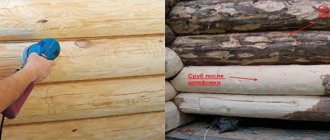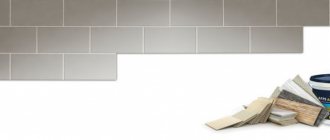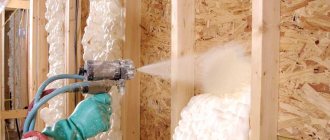Chasing walls for electrical installations in a house is a process where you have to both break and build at the same time.
For a standard two-room apartment, on average, up to 50 meters of grooves are cut. Moreover, for some reason, many are sure that all furrows are made exclusively for wires or plumbing pipes.
In the meantime, this work can be well combined with the manufacture of niches for socket boxes.
Requirements for grooves
First of all, let’s point out that you can’t just ditch the walls. There are regulated standards that formed SNiP 3.05.06-85. What does this document indicate:
- the depth of the groove should not exceed 2.5 cm, width 3 cm;
- the maximum length of one groove from the junction box to the socket or lamp is 3 m;
- Walls can be tapped for wiring either vertically or horizontally;
- an exception to the above point can only be the walls of the attic, because they have an inclined location, but even in this case, the grooves are laid parallel to the roof slope;
- distance along the wall from floor slabs - 15 cm minimum, from window and door openings - 10 cm minimum, from gas or heating mains - 40 cm;
- minimizing turns in electrical wiring, ideally a straight route, optimally with one turn at a right angle;
- It is impossible to groove in the corners of the room; this also applies to floor slabs and load-bearing walls.
Before moving on to the process of cutting walls for electrical wiring, it is recommended to draw a diagram on paper that shows the installation locations of lamps, switches and sockets, as well as the contours of the wires.
Vertical and horizontal arrangement of grooves Source elgrad.by
Dismantling the old line
Before completely replacing the electrical wiring in the apartment, you will need to dismantle the old networks. First, furniture and equipment are removed from the premises and completely emptied of all items. Then the power supply is turned off at the input. Having prepared, they begin to dismantle the finishing and network elements. It is most convenient to conduct it from distribution boxes. They are easy to “calculate” by the characteristic contours under the wallpaper or plastic covers.
After removing the lid from the box, disconnect the connections and pull the core out of the groove. Sometimes removing a cable in an apartment building is accompanied by severe damage to the wall structure. To avoid any major damage, the problem area is cut off, carefully isolated, and left in its original place. Having completed dismantling, they begin laying new lines.
Having assessed the scale of the event, many craftsmen ask: how to change the electrical wiring in an apartment at minimal cost? This option exists. With a small budget, they get by by adding missing lines, installing additional boxes, and connecting backup points.
The source of problems with the electrical network most often are connections (twisting, soldering). Therefore, partial repairs are considered a temporary solution.
It is strictly forbidden to directly connect aluminum and copper wires. The difference in their physical and chemical properties leads to a gradual breakdown of contact and destruction of the connection. Therefore, high-quality repairs require a complete reconstruction of the electrical network.
Old aluminum wire
What to ditch
If gating is entrusted to the shoulders of professionals, then they have one tool - a wall chaser. It belongs to the category of power tools, and is somewhat reminiscent of an angle grinder. But it has a serious difference - these are two cutting diamond discs that are installed on a rotating shaft. The distance between the disks can be increased or decreased to certain limits. This allows you to set the width of the future groove.
In addition, a wall chaser differs from an angle grinder in that its design has a protective casing in which a pipe is additionally installed. This is the link between the power tool and the vacuum cleaner. That is, when the discs cut hard material, dust flies out from under them, collects in the casing and is removed using a vacuum cleaner into the dust collector. The latter is either a bag or a container. Therefore, if the question is asked how to wall walls for wiring without dust, then you can answer it like this: choose a wall chaser.
There is another tool that the wall chaser is similar to. This is a furrower. So the latter has only one cutting diamond disc. And in this way it is very similar to an angle grinder, so this unit did not gain much popularity.
Wall chaser for forming grooves for wiring Source static.price.ru
Working with a wall chaser is quite simple. The main thing is that the edges of the grooves are smooth. In this case, you can always set the exact size of its depth and width. But at the same time, one must take into account the fact that this power tool does not make the groove itself. He simply cuts through its boundaries. The building material of the wall itself, which remains between the slots, will have to be removed either manually using a chisel and hammer, or with a hammer drill.
Before starting the process, a diagram of the electrical networks is applied to the wall. Prepare the tool: install diamond discs, set the cutting depth and width, connect a vacuum cleaner. Then they move directly to cutting the wall. The main task of the work manufacturer is to guide the wall chaser exactly along the lines marked on the walls.
Since the Bulgarian woman was mentioned in the conversation, she is the next tool for revealing our topic.
How a wall chaser works Source lordhire.co.uk
See also: Catalog of house projects made using permanent formwork technology.
Grinder for forming grooves
In general, it should be noted that the grinder is a universal tool. And it is often used for gating walls. But it is precisely in this process that there are many problems with it, three of which are special:
- a large amount of dust flying out from under the diamond disc;
- it is difficult to maintain the exact cutting depth because you have to do everything by eye;
- the ability to cut only one groove, that is, to obtain a groove you will have to go along the applied line twice, forming the width.
And even after such a large amount of work done, the groove is not yet ready. Here, as in the case of a wall chaser, you will have to gouge out the material between the grooves with a hammer drill.
Of course, in this case too you can fight dust. But for this it will be necessary to involve one more person in the work. Its task is to hold the suction pipe from the vacuum cleaner near the cut site with the disk. And even in this case, it will not be possible to say with one hundred percent certainty that this is dust-free gating. Some of it will still fly out and fill the room. Therefore, the worker must wear a respirator.
Grilling walls with a grinder Source teleinside.ru
See also: Catalog of companies that specialize in electrical work.
Impact drill or hammer drill
Let's move on to the topic of how to tap walls for wiring, and move on to two more power tools - an impact drill and a hammer drill. Basically, both tools work the same:
- holes are drilled to the required depth along the line marked on the wall every 2-3 cm;
- then the working body is changed, that is, the drill to a blade or chisel;
- the tool switches to the “no drilling” mode;
- then it is brought to the wall at an angle of 45°;
- The chiselling process begins, that is, a groove is formed by clearing out the remains of the material from which the wall was built.
Note that this method can also be classified as “high-speed”, but the quality of the groove leaves much to be desired. Essentially, a groove appears on the wall with jagged edges, large gouges, chips and cracks. True, this is a small nuisance, because subsequently, after laying the wires, the grooves are covered with a repair compound: plaster or putty.
Preparatory work
It is highly recommended that you draw up the wiring diagram correctly first. This is a very important detail of the preparatory work, as it performs several tasks:
- Allows you to calculate the exact number of cables, sockets, switches.
- Clearly displays the cable routes.
- Simplifies future network maintenance and troubleshooting.
Next, you need to prepare the surface to be treated: remove wallpaper, dowels, uneven surfaces, and other foreign objects. Then you need to check if there is any other wiring in the walls, and if there is, then make sure that it is not energized.
Video description
The video shows how to make a groove with a hammer drill:
Drill for drilling
Another option using a drill. That is, if a situation arises when professional tools are not available, then you can get by with a simple tool that the owner of the house always has in his arsenal. The whole process consists of drilling holes every 1-2 cm along the marked line, as in the previous case. For this, a Victory drill is used. But keep in mind that if the wall is concrete, you will have to drill it for a long time, which will increase the work time several times.
And then they use their grandfather’s old tools: a chisel and a hammer. They simply knock out the building material remaining between the holes in the wall.
The method is actually primitive. But if the task is to groove a short section of wall, then it justifies itself one hundred percent.
We will not separate into a separate section a method that uses a chisel and a hammer without additional tools. The option can be described as labor-intensive, time-consuming and with a low speed of construction operations. But it also happens if there is no drill at hand, and the length of the groove is within a couple of meters. True, the groove for the wiring will be of poor quality, and you will have to forget about its dimensions. But, as usual, a repair solution will fix everything.
How to make a groove with a chisel and hammer Source avatars.mds.yandex.net
Diamond blades
A very important thing when cutting grooves and sawing out niches is the quality of the diamond blades. You should never save money here and only buy well-known brands.
Even if your wall cutter or wall cutter is not Hilti or DeWalt but some other little-known brand, buy only expensive consumables. On cheaper diamond blades, the first thing that can wear off is not the diamond coating itself, but simply tearing out the seat under the fastening nut.
If buying a wall saw is an unaffordable luxury for you, but in the meantime you already have a hammer drill and don’t need to buy anything else, then work the old fashioned way.
For all the secrets of drilling out socket boxes, and ways to avoid breaking crowns when passing through reinforcement, read the link above.
Features of gating walls made of different materials
So, having sorted out the questions of what and how to wire the wall with, we move on to analyzing the wall materials. The simplest one here is plaster. It is soft, easy to cut, chisel, and drill. So there's no problem with her.
Difficulties will arise if the wall is concrete. Let us immediately note that a chisel and a hammer will not help here. That is, you can make a groove with them, but it will take a lot of time. The same can be said about a conventional drill, because even a Pobedit drill drills concrete for a long time, and it quickly burns out, losing its strength and cutting characteristics, so you have to often dip it in water to cool it. And this takes time.
As for brick, you can do without gating if the brickwork is not yet covered with plaster. The wires are simply laid in the seams between the bricks. In all other cases, you can use the tools described above, even a chisel and a hammer.
Strobe in a wall made of aerated concrete Source i.ytimg.com
The same problems can arise with concrete blocks as with a concrete monolithic wall. But with blocks made of cellular concrete there are fewer problems. The material does not have increased hardness, so it will not be difficult to make a groove in it.
Power tools
The most popular equipment for implementing the plan are:
- Bulgarian.
- Hammer.
- Wall chaser.
There are several practical nozzles that have been designed to collect dust and small elements of wall material generated during operation.
A special pump is responsible for the suction of particles; after all the manipulations, it is enough to empty the storage bag, which significantly reduces the time for cleaning in the room where the cable is laid. It will not be possible to completely get rid of debris, but its presence is reduced significantly, and the edges often remain smooth and neat.
Grilling load-bearing walls
And a few words about the impossibility of gating load-bearing walls. These restrictions mainly apply to city apartments. And especially those located in a multi-story building assembled from reinforced concrete slabs. The thing is that the reinforcement, which is the frame of the wall slabs, is located at a depth of 2-2.5 cm. That is, any groove will expose the reinforcement frame, reduce the thickness of the wall, increasing the risks of its deformation and collapse. Which, of course, cannot be allowed to happen.
With private houses everything is much simpler. Especially if they are built from bricks or blocks of various types. This takes into account the thickness of the wall and its load-bearing capacity. For example, if the wall is made of one and a half bricks, then you can make grooves in it without any problems.
There are, however, other options:
- carry out plastering, and make grooves in the applied layer;
- line the walls with plasterboard, plywood, chipboard or OSB, and lay electrical wires under them;
- carry out installation of wiring in special skirting boards, such as are present on the building materials market today.
Safety - how to hide wires from a child?
Wires in the public domain are a constant source of danger for young children. To prevent accidents, manufacturers offer a variety of protective elements - they prevent the child from coming into contact with live parts of the wiring.
There are manufacturers who offer entire series of security elements:
- fasteners that are difficult to break;
- boxes - wooden, plastic, cardboard;
- bags-covers for extension boxes.
All items that pose a danger to children are placed in boxes, which are placed in places inaccessible to them.
Methods
Figure 2. Grilling with a hammer drill
There are 4 methods of gating:
- Hammer and chisel - popular because they are cheap. Among the disadvantages, it is worth noting the duration of the work and the curvature of the highways.
- Impact drill - when using a hammer drill, the grooves come out with uneven edges, but the procedure is completed quickly.
- Grinder – there is a lot of dust when working. However, the grooves are smooth.
- Wall chaser – the main disadvantage is its high cost. However, it is fully justified by its efficiency: the recesses are smooth and dust-free.
Hammer and chisel combination
A hammer and a chisel are a classic set of tools for punching a surface, if we are not talking about concrete or sand-lime brick. You can try to break through a less durable red brick with this union.
This option is labor-intensive and time-consuming. A convenient approach to the development of plastered surfaces that does not require large expenses.
First you need to mark the future channel. Next, the chisel is placed across the drawn line, and the top of the handle is hit with a sledgehammer, first knocking out no more than 1 cm deep. In this case, the angle of inclination is maintained so strongly that the tool stands almost parallel to the wall. Greater deepening is performed in the next approach, as well as expansion, if required.
The chisel is not placed along the direction of movement, since a lot of excess will almost certainly be cut off, and the empty areas will have to be putty.











